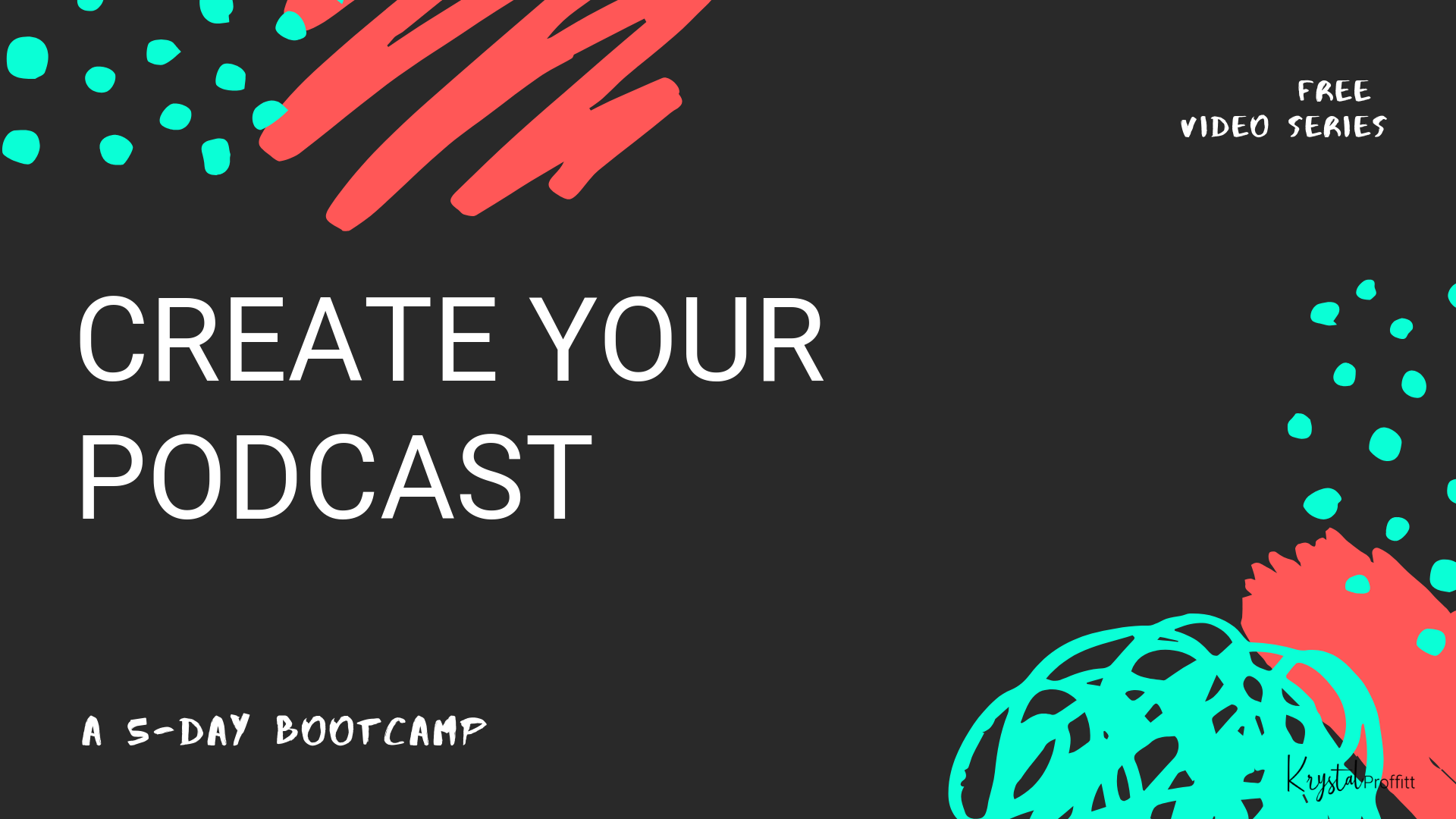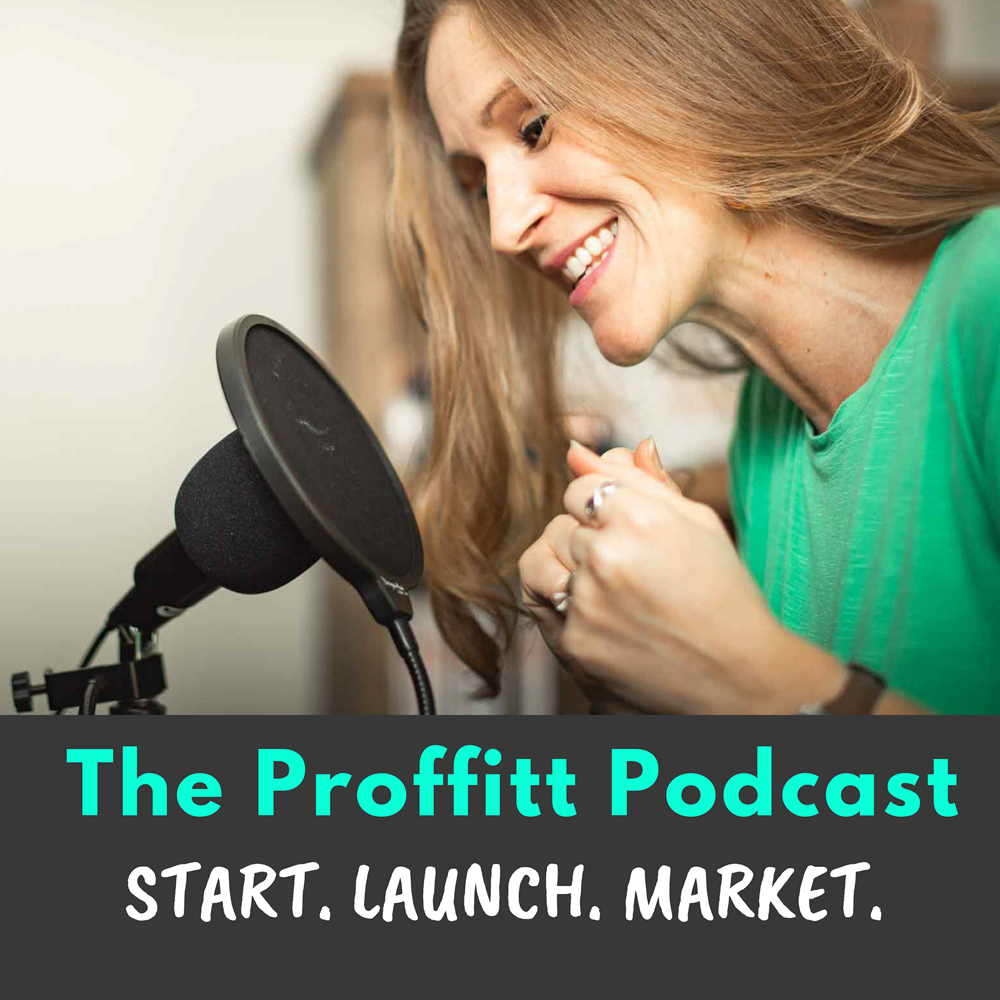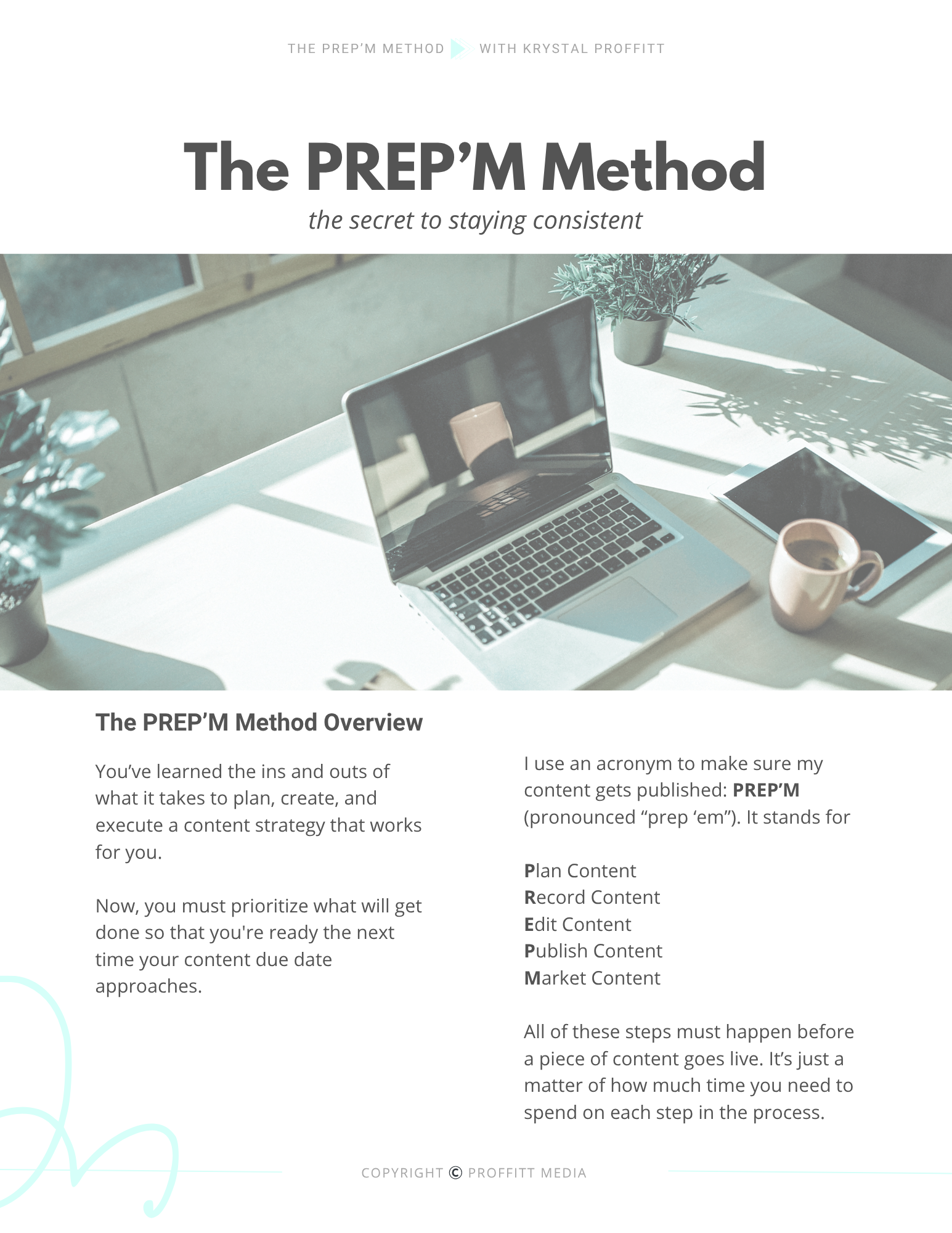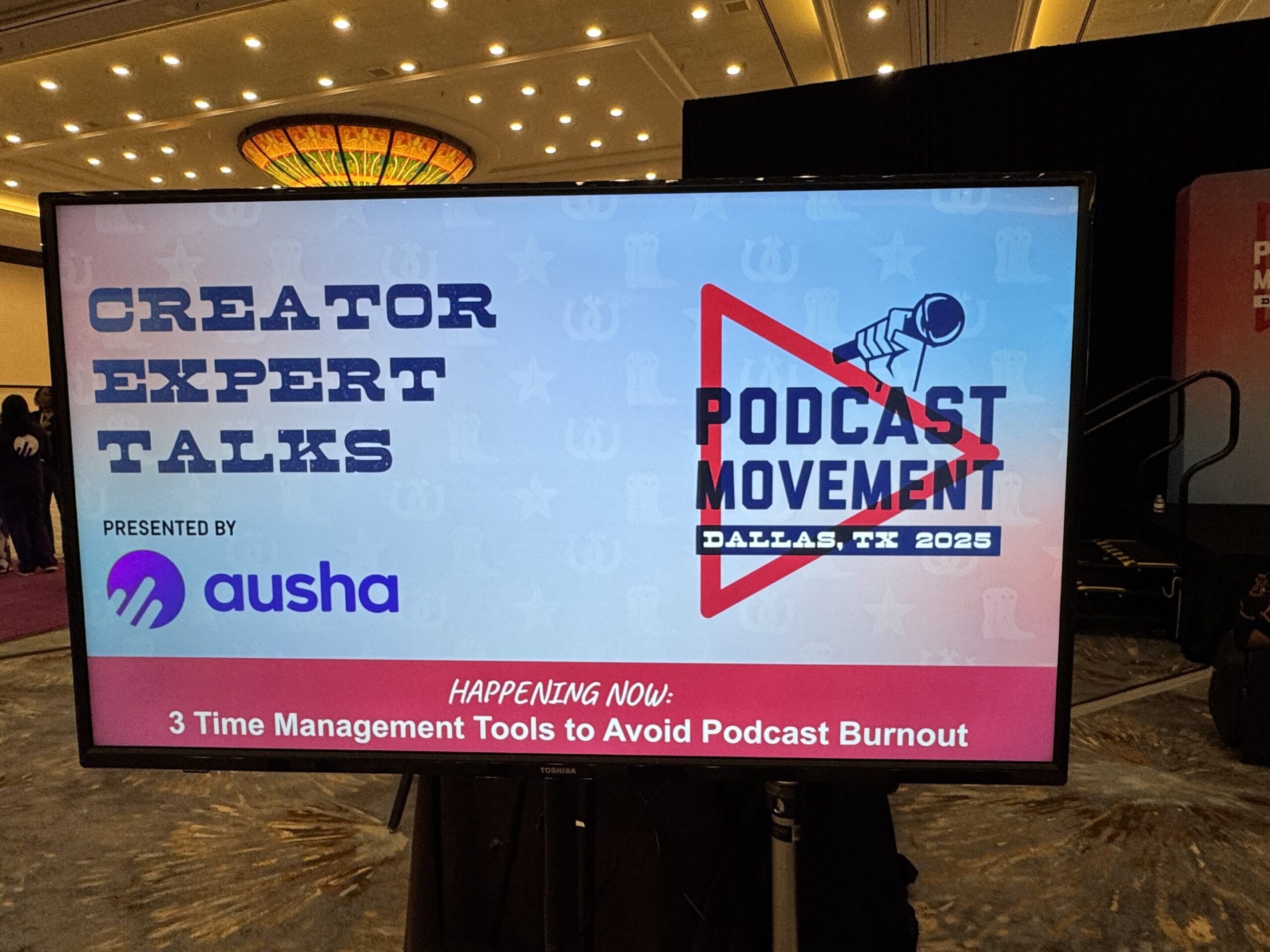WHAT’S THIS EPISODE ABOUT?
HOW TO FORMAT A PODCAST EPISODE
2 DIFFERENT TYPES OF PODCASTS
Solo Episodes vs. Interviews
I do a combo of the two types on The Proffitt Podcast because I like to have margin in my schedule. If an interview falls through because of a schedule conflict (which has happened multiple times #lifehappens!), then I still have control of my editorial calendar.
But even though they are technically 2 different types of podcast episodes, they are formatted the same way. Each one has a beginning, middle, and end.
Just like when you were a kid in an elementary writing class. You learned that a story needed to have a beginning, middle, and end. So does your podcast. Let’s break down how to format a podcast episode and what goes into each section.

BEGINNING: INTRO
(Between 30 second 1.5 minutes)
The beginning of your podcast is the first impression your listeners get when they tune in, so you want to grab their attention immediately. Depending on your target listener, this may mean playing some upbeat music and a happy tune to get them excited for what they’re about to experience.
For the record, there are many podcasts I listen to and dance to their intro music. This is definitely a lucrative way to get your audience pumped up!
This is the exact layout plan of my podcast (beginning to end) and how I time everything within each podcast episode.
Format a Podcast Episode Using My INTRO Example:
-
HOOK
- Attention-grabbing question, sentence, remark, story
-
PODCAST MAIN THEME
- This is the preformatted, prerecorded audio that I put into every single episode.
- You could say this each time if you wanted, but I find it easier to automate editing when you have certain things prerecorded.
- I think I’m going to an episode pretty soon about how you can automate sections of your podcast.
-
SELF-SPONSORED AD
- I KNOW I’m going to do an entire episode really about self-sponsored ads because everyone keeps asking me about them, but for today just know that’s a promotional piece of your podcast (just like any other kind of ad) where you promote your own thing.
- This could be a lead magnet to grow your email list, join your FB group, sell a product, sign up for a service, watch a video training, follow you on Twitter, leave a review, etc.
- Similar to a call-to-action, but more structured.
- I KNOW I’m going to do an entire episode really about self-sponsored ads because everyone keeps asking me about them, but for today just know that’s a promotional piece of your podcast (just like any other kind of ad) where you promote your own thing.

MIDDLE: MEAT OF THE EPISODE
(Between 20-50 minutes depending on the length of your podcast)
This is where things to start to differ whether it’s a solo or interview episode. Here are the main differences you’ll see in how you format each episode type.
-
SOLO PODCAST
- The meat of the episode
- Where you explain whatever you’re talking about for that particular episode. I’ve found it works best to plan and format your podcast episodes to almost tell a story. Even within the middle, you want your content to be structured so people can follow what you’re saying.
- In other words, you don’t want to be all over the place where no one can follow what you’re talking about.
- Make it easy to understand and follow.
- Numbers and bullet points within your outline can help you stay organized and help you cover everything you want to talk about in each episode.
-
INTERVIEW PODCAST
- SETTING THE STAGE
- The first few minutes after the Intro should be dedicated to setting the stage for your audience to listen to your interview.
- There are a few ways to do this. You can tell a short story about how you met your guest, how long you’ve known them, read a bio that your guest sent you before your interview, or you could list out their qualifications for the topic you’re speaking on.
- There isn’t a right way or a wrong way to do this, but I think it’s important that you give your guest a proper intro before you dive into the interview.
- The first few minutes after the Intro should be dedicated to setting the stage for your audience to listen to your interview.
- ACTUAL INTERVIEW
- This is exactly how it sounds, the podcast interivew you had with your guest.
- SETTING THE STAGE
Joined the Bootcamp Yet?
This is our FREE 5-day Podcast Video Series that walks you through the basics of podcasting!

CONCLUSION: OUTRO
(Between 1-5 minutes depending on the length of your podcast, RECAP/summary, and CTAs)
Wrap It Up!
Just like our writing teachers taught us, we need to close the story. I know I’ve talked about Donald Miller before because I’m OBSESSED with StoryBrand. Such an amazing book and you should grab it if you haven’t read it yet.
But he talks about closing story loops all of the time and we need to practice this in our marketing.
So, have you ever listened to a podcast, or watched a movie or read a book and thought, “That’s it? That’s the end of the story? Well, what about the farmer’s daughter that was left at the gas station? Or the airplane that went up in the air, but never landed? Or the topic she started talking about, but never came back to?”
We have to make sure we close ALL OF THE STORY LOOPS we opened in our podcast episodes.
So the OUTRO is where you want to do this. You don’t want to simply quit talking and play your music. Listeners will be confused about whether or not the episode was finished and may think you’re a little too messy for their listening pleasure and not come back next week to listen to your amazing content. And we DO NOT want that to happen!
There are a few ways to “WRAP IT UP”:
-
RECAP
- Go back and give a high-level overview of what you covered
-
By just saying, “That does it for this episode…”
- It cues the audience that it’s curtain call and that your time together is coming to an end.
-
Calls-to-Action that you didn’t go in the beginning or middle of the episode
- Some people prefer to leave this until the end and some want to make sure listeners don’t tune out so they throw them in the very beginning. I’m good either way as long as you have SOME CTA within your podcast episode! Doesn’t matter if it’s solo or an interview. You need CTAS!
-
Tell your audience where they can find the show notes for this episode.
- Be sure to say the actual URL. “You can find the show notes for this episode at KrystalProffitt.com/episode82.”
-
Throw in your tagline and music
- Officially walk your audience out the door of the episode, just like the gracious host that you are.
How to Format a Podcast: A FEW Extra NOTES
Feel free to add music, CTAs, and your tagline anywhere within the podcast episode. I simply put them in my show because that’s how I like to format my episodes. But feel free to plan around with the podcast format that’s going to work best for you and your audience.
And that’s it! Let me know if you have any other questions about how to format podcast episodes. I actually did a full YouTube video on this that I’ll link to in the show notes so if you’re a visual person, you can see how I break everything down.
RECAP: How to Format a Podcast Episode
- 2 DIFFERENT TYPES OF PODCASTS
- INTRO
- MIDDLE
- OUTRO
- Remember, CTAS, music, self-sponsored ads, and your tagline can go anywhere within the episode!
Links Mentioned in This Episode:
- The Chris Hogan Show
- “Everyday Millionaires” Book
- “The Simple Pin Podcast” with Kate Ahl
- “Over 1 Billion Pinterest Impressions per Month – What Does It Mean?” Simple Pin Podcast
- “StoryBrand” by Donald Miller
- “How to Format Solo Podcast Episodes” YouTube Video
- 5-Day Podcast Bootcamp
- Resource Library




Comments +